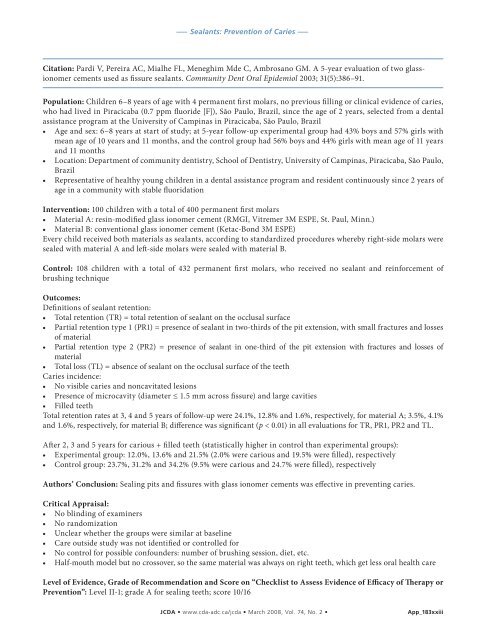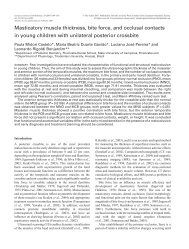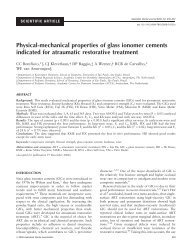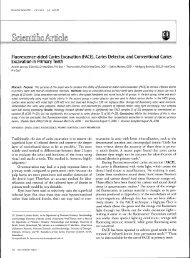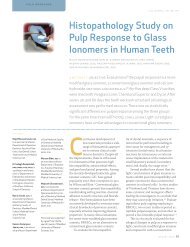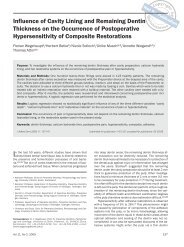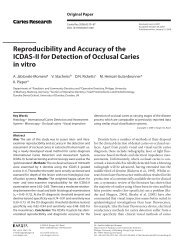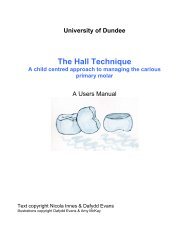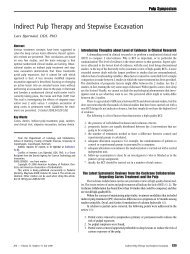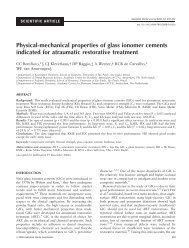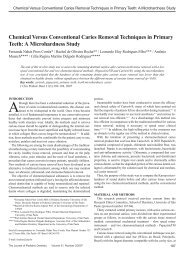Pit and Fissure Sealants in the Prevention of Dental Caries in ...
Pit and Fissure Sealants in the Prevention of Dental Caries in ...
Pit and Fissure Sealants in the Prevention of Dental Caries in ...
You also want an ePaper? Increase the reach of your titles
YUMPU automatically turns print PDFs into web optimized ePapers that Google loves.
––– <strong>Sealants</strong>: <strong>Prevention</strong> <strong>of</strong> <strong>Caries</strong> –––<br />
Citation: Pardi V, Pereira AC, Mialhe FL, Meneghim Mde C, Ambrosano GM. A 5-year evaluation <strong>of</strong> two glassionomer<br />
cements used as fissure sealants. Community Dent Oral Epidemiol 2003; 31(5):386–91.<br />
Population: Children 6–8 years <strong>of</strong> age with 4 permanent first molars, no previous fill<strong>in</strong>g or cl<strong>in</strong>ical evidence <strong>of</strong> caries,<br />
who had lived <strong>in</strong> Piracicaba (0.7 ppm fluoride [F]), São Paulo, Brazil, s<strong>in</strong>ce <strong>the</strong> age <strong>of</strong> 2 years, selected from a dental<br />
assistance program at <strong>the</strong> University <strong>of</strong> Camp<strong>in</strong>as <strong>in</strong> Piracicaba, São Paulo, Brazil<br />
• Age <strong>and</strong> sex: 6–8 years at start <strong>of</strong> study; at 5-year follow-up experimental group had 43% boys <strong>and</strong> 57% girls with<br />
mean age <strong>of</strong> 10 years <strong>and</strong> 11 months, <strong>and</strong> <strong>the</strong> control group had 56% boys <strong>and</strong> 44% girls with mean age <strong>of</strong> 11 years<br />
<strong>and</strong> 11 months<br />
• Location: Department <strong>of</strong> community dentistry, School <strong>of</strong> Dentistry, University <strong>of</strong> Camp<strong>in</strong>as, Piracicaba, São Paulo,<br />
Brazil<br />
• Representative <strong>of</strong> healthy young children <strong>in</strong> a dental assistance program <strong>and</strong> resident cont<strong>in</strong>uously s<strong>in</strong>ce 2 years <strong>of</strong><br />
age <strong>in</strong> a community with stable fluoridation<br />
Intervention: 100 children with a total <strong>of</strong> 400 permanent first molars<br />
• Material A: res<strong>in</strong>-modified glass ionomer cement (RMGI, Vitremer 3M ESPE, St. Paul, M<strong>in</strong>n.)<br />
• Material B: conventional glass ionomer cement (Ketac-Bond 3M ESPE)<br />
Every child received both materials as sealants, accord<strong>in</strong>g to st<strong>and</strong>ardized procedures whereby right-side molars were<br />
sealed with material A <strong>and</strong> left-side molars were sealed with material B.<br />
Control: 108 children with a total <strong>of</strong> 432 permanent first molars, who received no sealant <strong>and</strong> re<strong>in</strong>forcement <strong>of</strong><br />
brush<strong>in</strong>g technique<br />
Outcomes:<br />
Def<strong>in</strong>itions <strong>of</strong> sealant retention:<br />
• Total retention (TR) = total retention <strong>of</strong> sealant on <strong>the</strong> occlusal surface<br />
• Partial retention type 1 (PR1) = presence <strong>of</strong> sealant <strong>in</strong> two-thirds <strong>of</strong> <strong>the</strong> pit extension, with small fractures <strong>and</strong> losses<br />
<strong>of</strong> material<br />
• Partial retention type 2 (PR2) = presence <strong>of</strong> sealant <strong>in</strong> one-third <strong>of</strong> <strong>the</strong> pit extension with fractures <strong>and</strong> losses <strong>of</strong><br />
material<br />
• Total loss (TL) = absence <strong>of</strong> sealant on <strong>the</strong> occlusal surface <strong>of</strong> <strong>the</strong> teeth<br />
<strong>Caries</strong> <strong>in</strong>cidence:<br />
• No visible caries <strong>and</strong> noncavitated lesions<br />
• Presence <strong>of</strong> microcavity (diameter ≤ 1.5 mm across fissure) <strong>and</strong> large cavities<br />
• Filled teeth<br />
Total retention rates at 3, 4 <strong>and</strong> 5 years <strong>of</strong> follow-up were 24.1%, 12.8% <strong>and</strong> 1.6%, respectively, for material A; 3.5%, 4.1%<br />
<strong>and</strong> 1.6%, respectively, for material B; difference was significant (p < 0.01) <strong>in</strong> all evaluations for TR, PR1, PR2 <strong>and</strong> TL.<br />
After 2, 3 <strong>and</strong> 5 years for carious + filled teeth (statistically higher <strong>in</strong> control than experimental groups):<br />
• Experimental group: 12.0%, 13.6% <strong>and</strong> 21.5% (2.0% were carious <strong>and</strong> 19.5% were filled), respectively<br />
• Control group: 23.7%, 31.2% <strong>and</strong> 34.2% (9.5% were carious <strong>and</strong> 24.7% were filled), respectively<br />
Authors’ Conclusion: Seal<strong>in</strong>g pits <strong>and</strong> fissures with glass ionomer cements was effective <strong>in</strong> prevent<strong>in</strong>g caries.<br />
Critical Appraisal:<br />
• No bl<strong>in</strong>d<strong>in</strong>g <strong>of</strong> exam<strong>in</strong>ers<br />
• No r<strong>and</strong>omization<br />
• Unclear whe<strong>the</strong>r <strong>the</strong> groups were similar at basel<strong>in</strong>e<br />
• Care outside study was not identified or controlled for<br />
• No control for possible confounders: number <strong>of</strong> brush<strong>in</strong>g session, diet, etc.<br />
• Half-mouth model but no crossover, so <strong>the</strong> same material was always on right teeth, which get less oral health care<br />
Level <strong>of</strong> Evidence, Grade <strong>of</strong> Recommendation <strong>and</strong> Score on “Checklist to Assess Evidence <strong>of</strong> Efficacy <strong>of</strong> Therapy or<br />
<strong>Prevention</strong>”: Level II-1; grade A for seal<strong>in</strong>g teeth; score 10/16<br />
JCDA • www.cda-adc.ca/jcda • March 2008, Vol. 74, No. 2 • App_183xxiii


